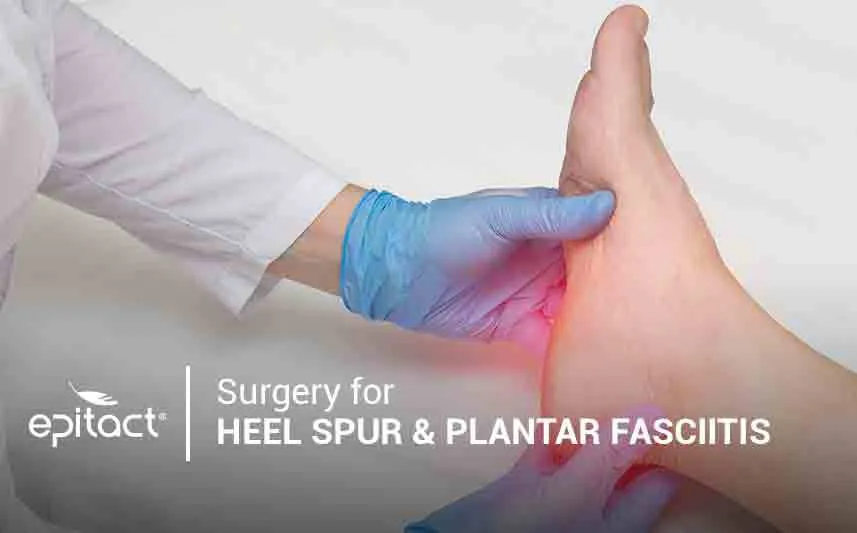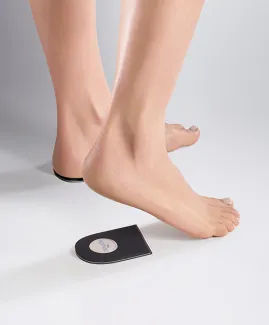
Considering a heel spur or plantar fasciitis surgery is often the last treatment option. However, this radical treatment approach remains rarely chosen since 90% of cases of plantar fasciitis heal with medical treatments(1)!
Who can have surgery for a heel spur or plantar fasciitis? Why and when to consider it? How does it happen? Can it be avoided? EPITACT® tells you everything about heel spur removal and plantar fasciitis surgery!
Heel spur and plantar fasciitis surgery: who is concerned?
People with persistent or painful heel spur or plantar fasciitis could potentially have surgery. By the way, surgery is more common for plantar fasciitis rather than heel spurs. Indeed, the inflammation of the plantar fascia is the cause of your pain whereas heel spurs are usually painless.
When to consider it?
In most cases, surgery for heel spur or plantar fasciitis is required if you do not respond well to medical treatments. They include:
- elimination of risk factors;
- orthoses or heel lifts*;
- stretching exercises;
- anti-inflammatory drugs;
- corticoisteroid injections.
If pain persists or comes back despite these treatments, removing the heel spur or having plantar fasciitis surgery should be considered.
What are the surgical procedures for heel spurs and plantar fasciitis?
Heel spurs and plantar fasciitis are closely-related conditions but each one has its proper surgical technique.
Plantar fasciitis surgery
Surgery for plantar fasciitis consists in treating the inflammation. To do that, the surgeon releases the plantar fascia by cutting it at the area where it attaches to the heel bone (calcaneus). It limits the stress at the base of the heel and reduces tension on the fascia. There are two main techniques:
- the open fasciotomy: the surgeon has a full view of the tissues involved thanks to a cut in the skin. This procedure allows you to totally resume your activities after 3 months. It can leave a scar from the incision(2).
- the endoscopic or percutaneous fasciotomy: the surgeon uses a small camera to precisely see the tissues to cut. Two incisions are made; the first for the camera, the second for the scalpel. This is the most common procedure as it allows you to rapidly resume your activities. It also entails less risks of complications. Only one week after plantar fasciitis surgery, 77% of patients wear their usual shoes(2).
The plantar fascia is partially or totally cut. For partial release, the surgeon only cuts the medial part of the plantar fascia (inwards the sole of the foot). This technique seems to be preferred compared with complete release, which involves a risk of foot arch collapse(3).
Heel spur removal
Bone spurs form because of plantar fasciitis. The surgeon can remove the heel spur but it is worth noting that this is not systematically the case. Although it is usually painless, the heel spur can be eliminated whether it accentuates pain and causes discomfort in the shoes. Otherwise, the surgeon can leave it.
For heel spur surgery, the percutaneous technique is common. A small incision allows the surgeon to access the painful area. First, he cuts a part of the plantar fascia at its insertion point on the calcaneus. Then, the surgeon removes the calcium deposit with a surgical burr.
Most of the time, both heel spur and plantar fasciitis surgeries only require regional anaesthesia from the leg to the toes. They only take a short time and are performed on an outpatient basis (you come and get back home the same day).
Recovery time after plantar fasciitis and heel spur surgery
The recovery period after plantar fasciitis surgery can range from a few weeks to several months. Generally, surgery is followed by 3 weeks of immobilisation and 3 additional weeks during which wearing loads should be limited(4).
The day of surgery, you may be able to walk normally or with crutches if you feel pain. In the beginning, it is recommended to apply slight or moderate foot pressure on the ground.
Patients who have surgery can expect a normal resuming to activities after 2 to 3 months. However, each patient should be previously informed about the possible complications of such treatment. Indeed, in some cases, residual heel pain can persist(5).
Nevertheless, heel spur removal or plantar fasciitis surgery are rarely suggested. In any case, preventing and relieving heel pain remain the first and best options.
*This solution is a class I medical device that bears the CE marking under this regulation. Carefully read the instructions before use. Manufacturer: Millet Innovation. 12/2023
For more details about this general and simplified approach, here are further sources:
(1)Miyamoto W, Takao M, Uchio Y. Calcaneal osteotomy for the treatment of plantar fasciitis. Arch Orthop Trauma Surg. févr 2010;130(2):151‑4.
(2)Trojian T, Tucker AK. Plantar Fasciitis. AFP. 15 juin 2019;99(12):744‑50.
(3)Miyamoto W, Takao M, Uchio Y. Calcaneal osteotomy for the treatment of plantar fasciitis. Arch Orthop Trauma Surg. févr 2010;130(2):151‑4. L’actualité rhumatologique 2013. Elsevier Health Sciences; 2013. Elsevier Health Sciences; 2013.
(4)Luffy L, Grosel J, Thomas R, So E. Plantar fasciitis: A review of treatments. Journal of the American Academy of PAs. janv 2018;31(1):20‑4.
(5)Martinelli N, Bonifacini C, Romeo G. Current therapeutic approaches for plantar fasciitis. Orthopedic Research and Reviews. 2014;6:33‑40.
 Pharmacie
Pharmacie